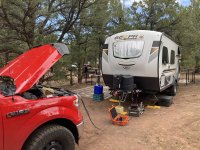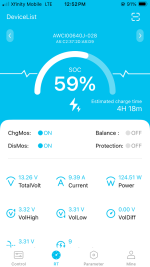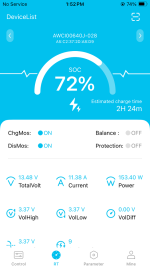Martinjmpr
Wiffleball Batter
UPDATE 6/5/2025: Field tested!
We took a trip to Flaming Gorge in Utah last weekend. No electrical hookups at all and we were camped in a large group campground, essentially 'boondocking' but with reservations.
As with our trip to Key West last year, I once again forgot to bring my external 100w solar panel so all I was left with was the 100w panel on the roof.
To be fair, the rooftop panel actually did a great job of keeping the batteries topped off. Temperatures were in the high 70's to low 80's so the refrigerator wasn't too stressed, and we were in a bit of a shady spot. Of course, with the only solar panel mounted on the roof, shade was a double edged sword: Yes, it kept the trailer cooler, but it also limited the amount of energy the solar panel could provide.
Still, when it was getting direct sun light, the on-board display for the solar controller showed a respectable 8 - 9 A going into the battery, which was actually more than I had expected.
However, by day 4 the battery state of charge was starting to get close to 50%. Even though I only had 2 more days before we got home, I decided to see how well my charging system would work.
So I hooked up the inverter to the SB175 connector and then plugged the 120v AC charger into the inverter and plugged it into the Anderson connector on the trailer.

It may look cumbersome but it actually took me less than 5 minutes to connect everything. It's basically all "plug and play."
Here is the display at the start of charging at 12:52:

And here it is exactly an hour later at 13:52:

If you're wondering why it is only showing 9.39 and then 11.38A of current, it's because there are actually two batteries so each battery is getting 15A max from the 30A charger. And the remainder of the discrepancy is the current shown is the NET current, and there is a draw from the 12v fridge, which (according to this display) draws anywhere between 7 - 9 A when the compressor is running.
So I'm definitely happy with the results, it's about what I had expected (and wanted.) I can put 30AH into the two batteries in an hour of idling the engine and I don't have to mess with a separate generator.
We took a trip to Flaming Gorge in Utah last weekend. No electrical hookups at all and we were camped in a large group campground, essentially 'boondocking' but with reservations.
As with our trip to Key West last year, I once again forgot to bring my external 100w solar panel so all I was left with was the 100w panel on the roof.
To be fair, the rooftop panel actually did a great job of keeping the batteries topped off. Temperatures were in the high 70's to low 80's so the refrigerator wasn't too stressed, and we were in a bit of a shady spot. Of course, with the only solar panel mounted on the roof, shade was a double edged sword: Yes, it kept the trailer cooler, but it also limited the amount of energy the solar panel could provide.
Still, when it was getting direct sun light, the on-board display for the solar controller showed a respectable 8 - 9 A going into the battery, which was actually more than I had expected.
However, by day 4 the battery state of charge was starting to get close to 50%. Even though I only had 2 more days before we got home, I decided to see how well my charging system would work.
So I hooked up the inverter to the SB175 connector and then plugged the 120v AC charger into the inverter and plugged it into the Anderson connector on the trailer.

It may look cumbersome but it actually took me less than 5 minutes to connect everything. It's basically all "plug and play."
Here is the display at the start of charging at 12:52:

And here it is exactly an hour later at 13:52:

If you're wondering why it is only showing 9.39 and then 11.38A of current, it's because there are actually two batteries so each battery is getting 15A max from the 30A charger. And the remainder of the discrepancy is the current shown is the NET current, and there is a draw from the 12v fridge, which (according to this display) draws anywhere between 7 - 9 A when the compressor is running.
So I'm definitely happy with the results, it's about what I had expected (and wanted.) I can put 30AH into the two batteries in an hour of idling the engine and I don't have to mess with a separate generator.



